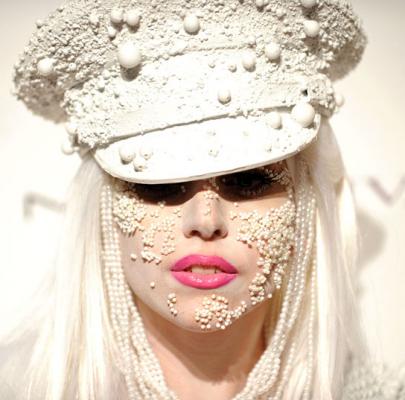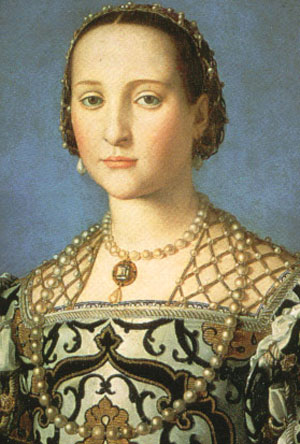Grading Pearls Protocol
A general maxim for grading pearls involves eight simple steps. The following pearl grading steps are used by pearl experts themselves and is the standard grading pearl protocol used by pearl collectors, pearl buyers and sellers.
 Lady Gaga embellished with Pearls
Lady Gaga embellished with PearlsPearls set in jewelry before 1920, are either Majorica pearls, Freshwater pearls, Imitation pearls or if you are very lucky, Natural pearls.
First, last, and midst, identifying Natural pearls is normally carried out by x-ray examination at special laboratories. Such an examination may be inconvenient or impossible because removing the gold mounting around the pearl (for x-ray purposes) might endanger an important Natural pearl, of Antiquity.
However, there are some identifying and pearl grading standards, useful as a general maxim, that you can perform at home, that will assist in grading pearls and even help in identifying Natural pearls.
By following this simple pearl grading system, comprised of eight steps you will be better equipped to identify Cultured pearls from other types of pearls and consequently you will have a better idea of the value of your pearls which helps if you are planning on selling them.
In the process, one will develop an eye for a pearl based on one's concepts of pearl quality.
The Mikimoto pearls grading system is universally accepted as the best pearl grading system in the world; the following grading pearl tips are based on the Mikimoto cultured pearl grading system and a general grading maxim for both cultured and natural pearls.
It is standard practice to grade pearls on either white cloth or white tissue paper. However, a red cloth is standard practice when grading Arabian Gulf Pearls.
The Eight Grading Pearls Steps
1. Size
2. Shape
3. Luster
4. Nacre Thickness
5. Complexion
6. Color
7. Matching
8. Orient
1. Size
Size does matter here. Pearls are measured in millimeters. The value of the pearl will increase with the size of the pearl. A 6-mm pearl, however, will not be twice the price of a 3-mm pearl but around 5 to 6 times the price of a 3-mm! If you are the lucky owner of a fine quality pearl over 20-mm, it belongs in a museum.
They are that rare! Usually, larger pearls are strung in the center of the necklace with the smaller pearls near the clasp.
2. Shape
When grading pearls have in mind, the closer the pearls come to achieving perfect round symmetry the greater their value. Since Mikimoto introduced Cultured pearls onto the marketplace in the 1920s, there has been a softening of prices. Round pearls are no longer the great rarity they once were. Pre 1920 pearls are a different story, however, perfectly round pearls are very rare and command prices that reflect this quality.
3. Luster
Luster is the reflection of light off the surface of a pearl. Luster can be compared to the 'brilliance' of a diamond. In a fine pearl, the mirror-like reflection off the skin of the pearl is crisp, sharp and clear. A decrease in the quality results in the increase in dullness.
4. Nacre Thickness
When grading pearls, determining the fineness of the pearl which is the thickness of the nacre layer is to be considered.
A simple method to check the thickness of the nacre is to roll a string of pearls on a white surface under strong lighting. Thin-skinned pearls will wink, appearing brighter and darker as the pearl is rotated.
5. Complexion (Skin; Blemish; Texture; Surface)
When grading pearls, if the texture or the complexion of a pearl is coarse or uneven it will detract from the beauty of the pearl. A complexion as close as possible to flawless in a pearl is the most desirable. The surface cleanliness (another description) of Cultured pearls or Natural pearls has a direct correlation to its perceived value.
A pearl can never, according to rules set forth by the FTC, be graded as "flawless" but the degree or percentage of inclusions can be measured.
The skin of the pearl should be smooth and velvety.
Think of the beautiful glowing, healthy skin of a new bride. In the case of symmetrical pearls, connoisseurs are most concerned about how the pearl will "face-up". In other words, will the imperfection be noticeable when set?
6. Color
The pearl's body color does not define by itself, the beauty of the gem. No particular hue is more beautiful than another. What Richard Wise terms "simpatico" is more important. With a grey pearl, for example, consider whether or not the gray acts as a mask, or is the foreground color more grey than silver. Silver-colored pearls are highly prized and much sought after.
7. Matching
Matching pearls, as the name implies, involves looking carefully at the pearls when you're grading pearls to make sure they all match all the categories in the above list, however, matching is not quite as simple as it sounds.
I think that 'matching' pearls is a much more complex process than in a standard grading pearl and this is where your 'eye for a pearl' becomes invaluable. Pearls age at different rates and every pearl has a lifetime. Some lose their luster in ten years, some in fifty years.
Consequently, you must match so that all the pearls in the string age at the same rate. That is not easy, if one pearl, for example, changes color before the rest it decreases the value of the necklace. Matching pearls is truly an art, not a science.
8. Orient

The word ORIENT comes from the Latin word, "Oriens" which means, 'the rising of the sun' (Wise, R.W., 2003 Secrets of the Gem Trade, Brunswick House Press, Massachusetts.).
Mr. Kokichi Mikimoto who stamped his name onto his pearls - Mikimoto Pearls would have used the word, "Oriental Pearls" to describe Natural Pearls as they were called Oriental pearls back then.
However the term "Orient" when it comes to pearl grading is a term loosely applied today, and it's meaning has become obscured. Do the people imagine a vain thing? Not so. Pearl Orient is one of the most important qualities to look for when grading pearls.
Think and compare... Glassy, Sunny, Noonday Sun, Cloudless, Clear and Unobscured Surfaces.
A Pearl that possesses true Orient, has an inner radiance and glow, and given time, will ultimately possess you.
A poetic description that does fit better than any scientific description was written by the English Renaissance poet, Thomas Campion, who described little pearls that "looked like rosebuds fill'd with snow". (Wise, R., "A Meditation on Pearls" Pearl World, vol., no. 3, July-September 2001, pp. 10-11.)
Orient, is not found in all species of pearls. Of the Australian South Sea Pearls, only the very finest will display orient. Interestingly, in South Sea black pearls it is the defining quality.
Orient, will only appear in cultured pearl varieties with a thick coating of nacre. Although 'orient' may occur in Akoya Pearls, be cautious, it could indicate a pearl cheat.
Finished, good lady; the bright day is done. Now you too can grade pearls just like the experts using the above eight steps.
Have you Seen the Jewel-of-the-Month Yet?
Return to the top of Grading Pearls
Return to Cultured Pearls
Return to Antique Jewelry Investor Home Page
